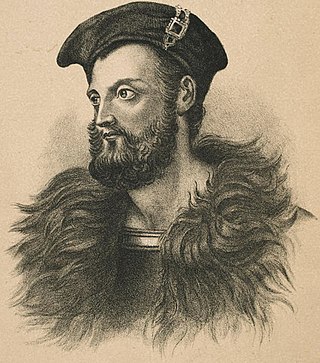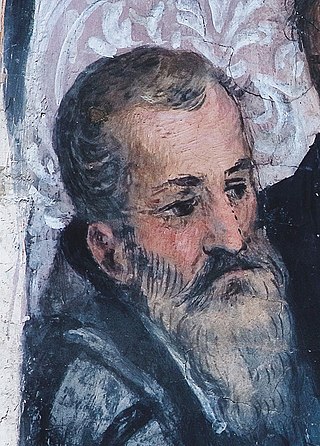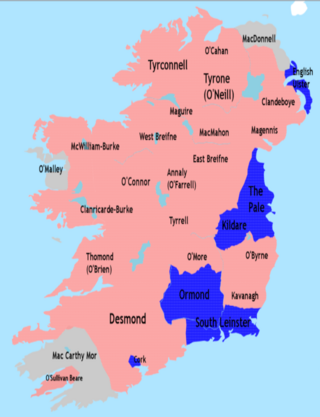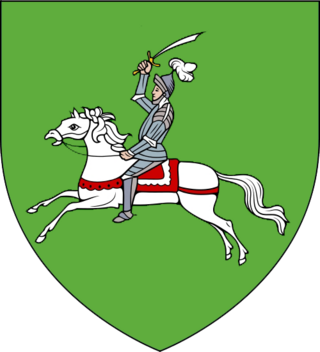Related Research Articles

Owen Roe O'Neill was a Gaelic Irish soldier and one of the most famous of the O'Neill dynasty of Ulster. O'Neill left Ireland at a young age and spent most of his life as a mercenary in the Spanish Army serving against the Dutch in Flanders during the Eighty Years' War. After the Irish Rebellion of 1641, O'Neill returned and took command of the Irish Confederate Ulster Army. He is known for his victory at the Battle of Benburb in 1646.

Hugh O'Neill, Earl of Tyrone was an Irish Gaelic lord and key figure of the Nine Years' War. Known as the "Great Earl", he led the confederacy of Irish clans against the English Crown in resistance to the Tudor conquest of Ireland under Queen Elizabeth I.

The Irish Confederate Wars, also called the Eleven Years' War, took place in Ireland between 1641 and 1653. It was the Irish theatre of the Wars of the Three Kingdoms, a series of civil wars in the kingdoms of Ireland, England and Scotland – all ruled by Charles I. The conflict had political, religious and ethnic aspects and was fought over governance, land ownership, religious freedom and religious discrimination. The main issues were whether Irish Catholics or British Protestants held most political power and owned most of the land, and whether Ireland would be a self-governing kingdom under Charles I or subordinate to the parliament in England. It was the most destructive conflict in Irish history and caused 200,000–600,000 deaths from fighting as well as war-related famine and disease.

Sir Phelim Roe O'Neill of Kinard was an Irish politician and soldier who started the Irish rebellion in Ulster on 23 October 1641. He joined the Irish Catholic Confederation in 1642 and fought in the Wars of the Three Kingdoms under his cousin, Owen Roe O'Neill, in the Confederate Ulster Army. After the Cromwellian conquest of Ireland O’Neill went into hiding but was captured, tried and executed in 1653.

The Irish Rebellion of 1641 was an uprising in Ireland, initiated on 23 October 1641 by Catholic gentry and military officers. Their demands included an end to anti-Catholic discrimination, greater Irish self-governance, and return of confiscated Catholic lands. Planned as a swift coup d'état to gain control of the Protestant-dominated central government, instead it led to the 1641–1653 Irish Confederate Wars, part of the wider Wars of the Three Kingdoms.

The Nine Years' War, sometimes called Tyrone's Rebellion, took place in Ireland from 1593 to 1603. It was fought between an Irish confederation—led mainly by Hugh O'Neill of Tyrone and Hugh Roe O'Donnell of Tyrconnell—against English rule in Ireland, and was a response to the ongoing Tudor conquest of Ireland. The war began in Ulster and northern Connacht, but eventually engulfed the entire island. The Irish alliance won numerous victories against the English forces in Ireland, such as the Battle of Clontibret (1595) and the Battle of the Yellow Ford (1598), but the English won a pivotal victory against the alliance and their Spanish allies in the siege of Kinsale (1601–02). The war ended with the Treaty of Mellifont (1603). Many of the defeated northern lords left Ireland to seek support for a new uprising in the Flight of the Earls (1607), never to return. This marked the end of Gaelic Ireland and created the groundwork for the foundation of the Plantation of Ulster.

Hugh Maguire was an Irish nobleman and military commander who served in the Nine Years' War. As Chief of the Maguire clan and Lord of Fermanagh, he was the first of the Gaelic chiefs to openly rebel against Elizabeth I's conquest of Ireland.

Lisnarick or Lisnarrick is a small village in County Fermanagh, Northern Ireland, 4 km west of Irvinestown. It is situated in the civil parish of Derryvullan and historic barony of Lurg. The village was once known as Archdalestown after the nearby Castle Archdale. In the 2011 Census it had a population of 238.

Tully Castle is a castle situated in County Fermanagh, Northern Ireland, near the village of Blaney, on Blaney Bay on the southern shore of Lower Lough Erne. The Blaney area takes its name from Sir Edward Blaney, who was among the English advance party sent to Fermanagh to organise the Plantation.
Sir Rory O'Moore, also known Sir Roger O'Moore or O'More or Sir Roger Moore, was an Irish landowner, and is most notable for being one of the four principal organisers of the Irish Rebellion of 1641.
Hugh McShane O'Neill was an early modern Irish nobleman and rebel associated with the McShanes of Glenconkeyne and Killetra. This group was also called the "Wild Clan Shanes of Killetragh" or the "McShane-O'Neills". His parentage is disputed however he is claimed by some as being either a grandson or great-grandson of Conn O'Neill, 1st Earl of Tyrone, and Gearoid Mór Fitzgerald, 8th Earl of Kildare, and of the primary line of the O'Neill of Tyrone clan.
Sir Herbert Charles Arthur Langham, 13th Baronet was an English landowner, photographer, ornithologist and entomologist.
McCaul, also spelt MacCawell is an Irish surname, derived from the Gaelic Mac Cathmhaoil, meaning the "son of Cathmhaol", descendant of being implied. The name Cathmhaoil itself is derived from cath mhaol meaning "battle chief". The Mac Cathmhaoil were the leading family of Cenél Fearadhaigh, of the Uí Néill, and were based around Clogher in modern-day County Tyrone, Northern Ireland. They were one of the seven powerful septs that supported the O'Neills. Mac Cathmhaoil is now rare in Ulster as it has been Anglicised under various different forms such as, Campbell, McCawl, Caulfield, McCall, Alwell, Callwell, McCowell, Cowell, McCuill, Howell, MacHall, and McQuade.
Connor Maguire, 2nd Baron of Enniskillen was an Irish nobleman from Ulster who took part in the Irish Rebellion of 1641. He was executed for high treason.
Colonel Philip O'Reilly was a member of parliament for County Cavan, Ireland in the Irish Parliament from 1639 to 1641, and a leading member of the 1641 Rebellion.

The Treaty of Mellifont, also known as the Articles of Mellifont, was signed in 1603, ending the Nine Years' War which took place in the Kingdom of Ireland from 1594 to 1603.

Crevenish Castle is a ruined castle and bawn in County Fermanagh, Northern Ireland, 3k south-west of Kesh at grid ref: H165626. It is privately owned.

The Maguire family is an Irish clan based in County Fermanagh. The name derives from the Gaelic Mac Uidhir, which is "son of Odhar" meaning "dun", "dark one". According to legend, this relates to the eleventh descendant of Colla da Chrich, great-grandson of Cormac mac Airt, who was monarch of Ireland about the middle of the third century. From the 13th to the 17th centuries, the Maguire family were kings of Fermanagh.
Colonel Rory Maguire was an Irish politician and soldier. He was a leading instigator of the Irish Rebellion of 1641 and subsequently participated in the Irish Confederate Wars as a senior Confederate commander.
Sir William Cole (c.1571–1653) was an English soldier and politician, who participated in the Plantation of Ulster and established a settler town at Enniskillen, County Fermanagh. Despite his initial loyalty to the Stuarts, he was a leading English Parliamentarian figure in the Irish Confederate Wars of the 1640s.
References
- 1 2 3 4 Gillespie, Raymond (1993). "The Murder of Arthur Champion and the 1641 Rising in Fermanagh". Clogher Record. 14 (3): 52–66. Retrieved 19 February 2023.
- ↑ Clavin, Terry (October 2009). "Maguire, Rory (Roger)". Dictionary of Irish Biography. Retrieved 18 February 2023.